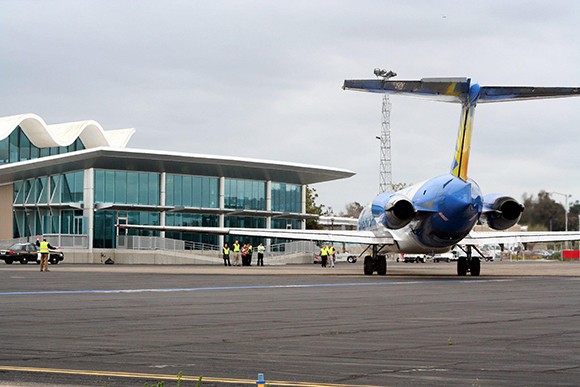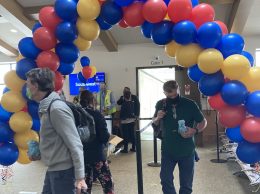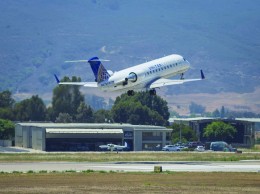Business flyers trade bigger planes for fewer flights
IN THIS ARTICLE
- Latest news Topic
- Erika Martin Author
By Erika Martin Friday, March 27th, 2015

United Airlines will begin routing flights from the Santa Maria Public Airport to San Francisco International instead of Los Angeles International beginning May 9. (Courtesy photo)
Small commercial airports may be headed the same way as stratospheric smoking sections and lenient security screening — a relic of the industry’s giddy boom days when airlines vied for the plumpest flight schedule and most posh flight experience.
The standard practice at airlines now is to cut operations to their bare bones, a trend that is thinning the ranks of commercial airlines in the Tri-Counties, most recently with Frontier Airlines’ departure from Santa Barbara Municipal Airport (SBA) as the company pushed its flights toward the East Coast.
That left United Airlines as the region’s dominant carrier, just as the company decided to begin using larger planes and fewer flights.
The airline — whose service in San Luis Obispo and Santa Maria is operated by SkyWest Airlines as United Express — will cut the number of flights it offers to and from the San Luis Obispo County Regional Airport (SLO) in half beginning April 7, when it plans to shelf its fleet of turboprop commuter planes in favor of larger regional jets.
Meanwhile at the Santa Maria Public Airport (SMX), United will begin flying to and from San Francisco, dropping service to Los Angeles International Airport beginning May 9.
According to United Airlines’ website, the number of flights available to LAX and San Francisco International from SLO will drop from 11 to five, increasing layover times and reducing availability.
The company also made some unannounced changes to its Santa Barbara flight plan, cutting a few flights and most notably rescheduling its first flight to LAX from 6:30 a.m. to 9:18 a.m. — too late in the day for business travelers to reach connecting flights that will get them to the East Coast before dinner.
In fact, the airline changed its schedule so abruptly that David de L’Arbre, chief operating officer at the Santa Barbara Travel Bureau, was left scrambling to reschedule flights his clients had paid for before they were unexpectedly canceled by United.
L’Arbre said the loss of early morning flights “is really pretty brutal” considering how much less reliable service through SFO can be: “Anyone who goes there knows it’s like playing Russian roulette with your schedule.”
The tourism industry should also be concerned with diminishing service, L’Arbre said, since both business and leisure travelers will choose destinations that are cheaper and easier to get to.
“There’s this huge ripple effect,” L’Arbre said. “It will raise the cost of businesses operating in and out of Santa Barbara, since smaller capacity and fewer flights means higher fares.”
Other than United, the area is only served by US Airways, which provides limited service to Phoenix from SBA and SLO; Alaska Airlines, which runs once-daily flights between Santa Barbara and Portland or Seattle; and Allegiant Air, which operates one flight a day between Santa Maria and Las Vegas.
By May, SkyWest plans to have scrapped its entire fleet of 28-passenger Embraer EMB 120 Brasilia turboprop commuter planes in favor of 50-passenger Bombardier CRJs.
According to Wes Horrocks, corporate communications manager at SkyWest Airlines, “the idea behind the schedule changes is to keep the seat count consistent.” There are about 516 daily round-trip seats available now, but that number will drop to 458 seats on April 7.
Horrocks said the regional jets “really are an upgraded service” and will deliver faster flights, more space and greater mechanical and scheduling reliability.
In a statement released when SkyWest announced the decision last November, the company also cited “increased costs and challenges associated with new [Federal Aviation Administration] flight and duty rules” implemented in January of last year to give commercial pilots longer breaks between flights.
As far as the decision to route flights from SMX through San Francisco rather than L.A. is concerned, Horrocks said the move was in response to direction from United Airlines, which uses SFO as a fortress hub.
In 2011, SBA opened its new terminal, which took two years and cost $54 million to complete. Since then, Delta Air Lines, American Airline’s American Eagle network and Frontier Airlines have ceased service from the airport, and no new carriers have come in.
Luckily, SLO and Santa Maria both have runways long enough to accommodate the larger aircraft; some similarly sized airports with shorter runways have lost United Express service altogether. The SLO airport is also working through plans for a $27 million renovation that would better accommodate larger planes, a project it hopes to complete in early 2017.
Horrocks said the airline may add flights back to its SLO schedule if there’s strong enough demand. “We want people to be able to fly out of San Luis Obispo and these other regional airports,” he said.
In recent years, Santa Barbara has been successful in marketing itself as an alternative to LAX while Santa Maria and San Luis Obispo have been exploring new destinations, with both looking at Denver as a top pick. But the latest maneuvers by United will mean a race to remain in survival mode as travelers will increasingly look to Burbank and LAX for convenience and cost savings.












